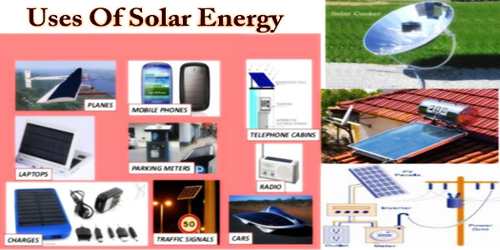In easy words, the energy which we get from the sun is called “Solar Energy”. We convert solar energy from the sun using solar panels into electricity and use it in our homes and business. In this era of renewable energy, solar energy has become a principal topic for environmental care. It is an essential source of renewable energy, and its technologies are broadly characterized as either passive solar or active solar depending on how they capture and distribute solar energy or convert it into solar power. Active solar techniques include the use of photovoltaic systems, concentrated solar power, and solar water heating to harness the energy. Passive solar techniques include orienting a building to the Sun, selecting materials with favorable thermal mass or light-dispersing properties, and designing spaces that naturally circulate air.
Solar energy, radiation from the Sun capable of producing heat, causing chemical reactions, or generating electricity. The total amount of solar energy incident on Earth is vastly in excess of the world’s current and anticipated energy requirements. If suitably harnessed, this highly diffused source has the potential to satisfy all future energy needs. In the 21st century, solar energy is expected to become increasingly attractive as a renewable energy source because of its inexhaustible supply and its nonpolluting character, in stark contrast to the finite fossil fuels coal, petroleum, and natural gas.
The Earth receives 174 petawatts (PW) of incoming solar radiation (insolation) at the upper atmosphere. Approximately 30% is reflected back to space while the rest is absorbed by clouds, oceans, and landmasses. The spectrum of solar light at the Earth’s surface is mostly spread across the visible and near-infrared ranges with a small part in the near-ultraviolet. Most of the world’s population lives in areas with insolation levels of 150–300 watts/m², or 3.5–7.0 kWh/m² per day.
The potential for solar energy is enormous since about 200,000 times the world’s total daily electric-generating capacity is received by Earth every day in the form of solar energy. Unfortunately, though solar energy itself is free, the high cost of its collection, conversion, and storage still limit its exploitation in many places. Solar radiation can be converted either into thermal energy (heat) or into electrical energy, though the former is easier to accomplish.
According to a report by the International Energy Agency (2017), the use of solar energy has exploded and we have found the growth of solar energy to be higher than all other fuels. The day is not far off when all of us will collect electricity and enjoy solar energy. The large magnitude of solar energy available makes it a highly appealing source of electricity. The United Nations Development Program in its 2000 World Energy Assessment found that the annual potential of solar energy was 1,575–49,837 exajoules (EJ). This is several times larger than the total world energy consumption, which was 559.8 EJ in 2012.
Uses of Solar Energy –
Our sun is the source of all life on Earth, and solar energy is useful to us in many different ways. The sun creates two main types of energy light and heat that we can harness for many activities ranging from photosynthesis in plants to creating electricity with photovoltaic (PV) cells to heating water and food. Let’s explore some common uses and benefits of sunlight in our daily lives.
Solar Electricity: This is one of the solar energy applications that has gained a lot of momentum in recent years. As solar panel costs decline and more people become aware of the financial and environmental benefits of solar energy, solar electricity is becoming increasingly accessible. While still a very small percentage of the electricity generated in the U.S. (1.9% in 2017), solar electricity is growing rapidly (almost tripling over a three year period and up +40% versus 2016) according to the U.S. Energy Information Administration.
Companies make solar panels from silicon and the cells combine to form solar energy (solar power). When photons (light rays from the sun) collide with a solar cell, they lose electrons from their atoms. When the positive and negative sides of the conductor cell connect, then it forms an electrical circuit and when electrons flow through such a circuit, it generates electricity.
A distributed solar PV system is typically installed on the rooftops of homes or businesses. These solar power systems generate electricity to offset the property owner’s usage and send any excess production to the electric grid.
A solar battery can connect to your solar power system to enable you to use solar after the sun goes down, power an EV overnight, or provide backup power during emergencies. Some homeowners may choose to go completely off the grid with a solar power and battery system or a solar power and generator system. In some cases, solar PV may be installed on an adjacent structure such as a barn or mounted to the ground, and then connected to the meter using underground cabling.
Other uses for solar energy include utility-scale solar PV farms that can generate enough electricity to power entire cities. An even more efficient solar technology is concentrated solar power (CSP). A CSP solar farm uses mirrors to reflect and concentrate the sun’s energy towards a tower or other receiver, generating heat that can power a turbine to create electricity. That thermal energy may be stored before powering a generator, which makes it a more flexible source of electricity than solar PV. The world’s largest CSP solar farm is the 390 megawatts (MW) Ivanpah project in California’s Mojave Desert; although an even larger 580 MW CSP plant under construction in Morocco may soon claim that title.
Solar Heating: Many homeowners are unaware that solar water heaters and solar space heaters are an effective way to heat one’s home without making the larger investment of installing solar panels. Solar space heaters harness sunlight and convert it into thermal energy with the use of liquid or air as a medium, while solar water heaters use water as a method for thermal transfer. These solar heating systems can either be passive or active while passive systems utilize natural circulation, active systems use pumps to circulate water and generate heat. Homeowners who install a thermal solar array on their roof can expect 5 to 10 percent returns with a system that costs a fraction of full solar panel installation.
A major benefit of solar thermal technology is the ability to heat your pool at a more cost-effective rate than conventional alternatives such as oil and gas pumps. According to the U.S. Department of Energy, “solar pool heating is the most cost-effective use of solar energy in many climates.” The technology uses a solar collector that harnesses sunlight and converts it into heat; Water is then drawn through the collector as a means of heating the pool. This technology can also be used to cool the water at night (typically necessary only in hotter climates). Solar heating systems range between $3,000 and $4,000 and can provide a payback period as short as one and a half years.
Cooking: Solar cookers use sunlight for cooking, drying, and pasteurization. They can be grouped into three broad categories: box cookers, panel cookers, and reflector cookers. The simplest solar cooker is the box cooker first built by Horace de Saussure in 1767. A basic box cooker consists of an insulated container with a transparent lid. It can be used effectively with partially overcast skies and will typically reach temperatures of 90–150 °C (194–302 °F). Panel cookers use a reflective panel to direct sunlight onto an insulated container and reach temperatures comparable to box cookers. Reflector cookers use various concentrating geometries (dish, trough, Fresnel mirrors) to focus light on a cooking container. These cookers reach temperatures of 315 °C (599 °F) and above but require direct light to function properly and must be repositioned to track the Sun.
Solar Ventilation: Solar ventilation solutions such as solar attic fans can reduce the burden of our HVAC by helping to cool our home during the summer. This may be a good option if you are not able to install a solar PV system that offsets your home’s entire electricity use. One innovative product is the Solatube solar attic fan.
Commercial and industrial applications of solar process heat include solar ventilation technologies that can preheat a building’s air in cold climates, reducing energy costs.
Solar Lighting: It is a popular example of solar energy. Solar lights have become ubiquitous and can be found everywhere from home landscaping and security lights to road signs and street lights. These solar lighting technologies for our home are inexpensive and readily available from basic to high-end designs everywhere from your local hardware store to online shopping websites such as Amazon.com.
One innovative use of indoor solar lighting, featured on Mashable, is the Solatube skylight that adds natural light while reducing energy usage.
Wearable Solar Tech: Powering consumer electronics has become a common solar power use in today’s world solar-powered chargers like Anker’s Power-port can charge anything from a cell phone to a tablet or e-reader. There are even solar-powered flashlights that can be charged by being exposed to sunlight. For those curious about the top products in solar tech, check out this top 10 lists of uses for solar devices:
- Cell phones
- Wearable’s
- Music speakers
- Solar air conditioning
- Tablets
- Thermostats
- Solar dryers
- Solar visor radios
- Freezers/mini-fridges
- Rechargeable flashlights
As the world moves away from fossil fuels and seeks renewable sources for everyday electronics, there’s no doubt that solar will continue to be adopted by the masses for any product that can be exposed to sunlight. The ultimate goal: use solar products to reinvent the way we think about power usage, and reverse the expectation for how devices should be charged. And as the conversion efficiency of solar continues to improve, this trend will expand into new markets and new products.
For example, wearable solar could soon make Apple Watches and Fit bits much more appealing to consumers, unlike their standard counterparts, solar-powered smartwatches don’t need to be plugged in to recharge every night.
Solar Transportation: Solar-powered vehicles may be the future, with existing applications including buses, trains, airplanes, and race cars built by students in Australia and the U.S. A fully solar-powered car is even slated for commercial release in 2019. This use of solar energy is not yet widely available unless you own an electric car or EV and charge it with solar panels (generally via a solar-connected battery).
Solar Energy is an excellent alternative to other energy sources, but the government needs to work more in this direction. Also, they have to spread awareness about the importance of solar energy. If we still use the traditional electricity system, in the coming generation there will be an extensive lack of all resources other than solar energy in this world. Successfully increasing the use of solar energy has led us to expect growth in industrial development and to explode. Now lots of people are using solar equipment all over the world. Because of solar energy, lots of business is developing everywhere.
Information Sources:
















